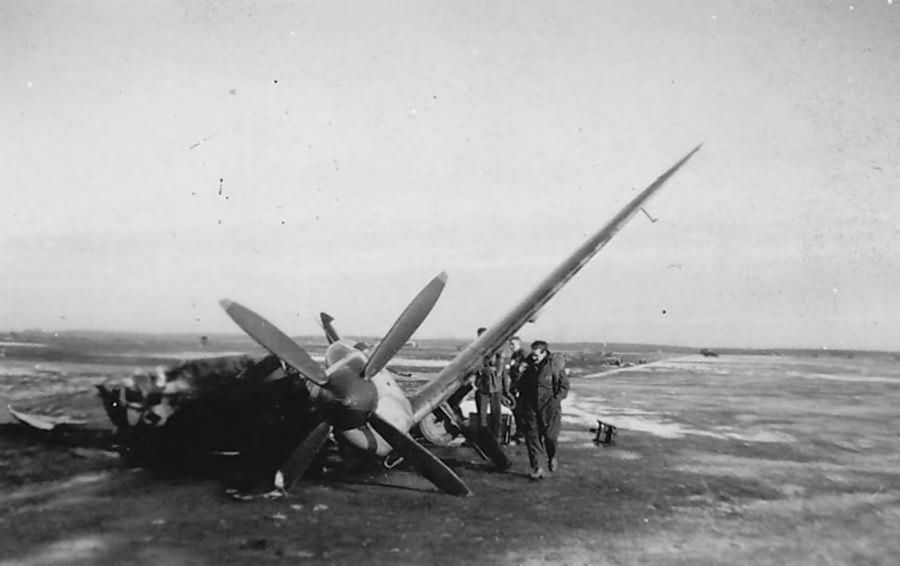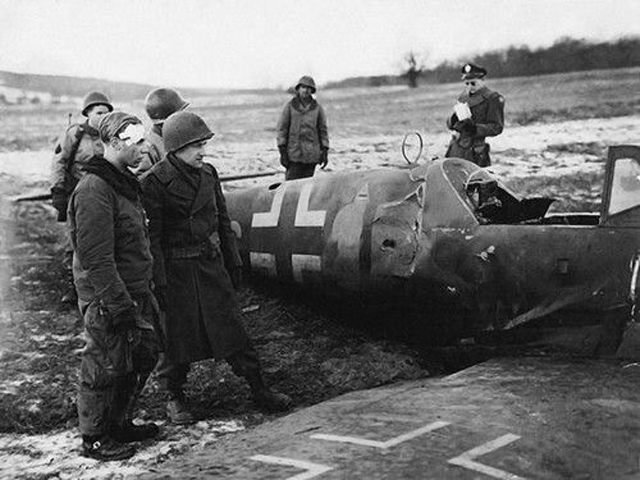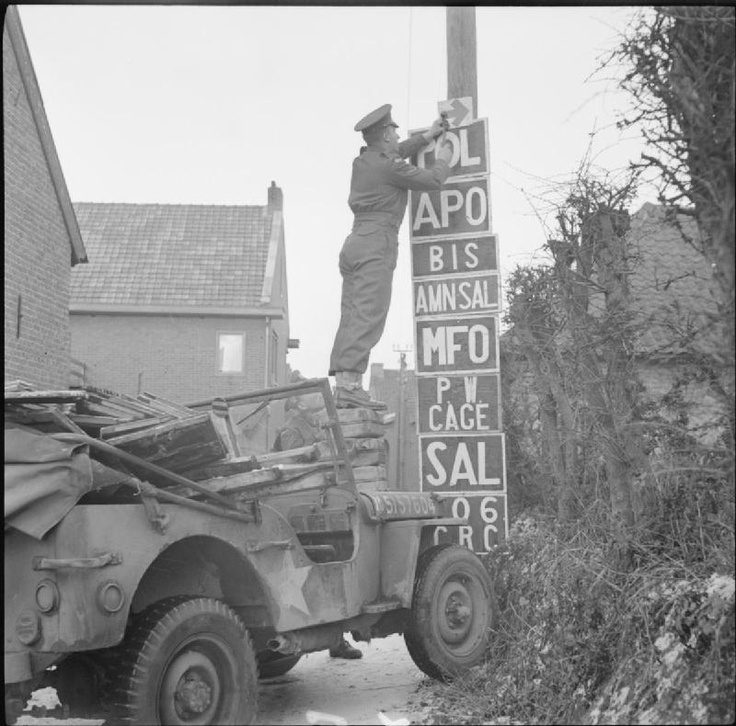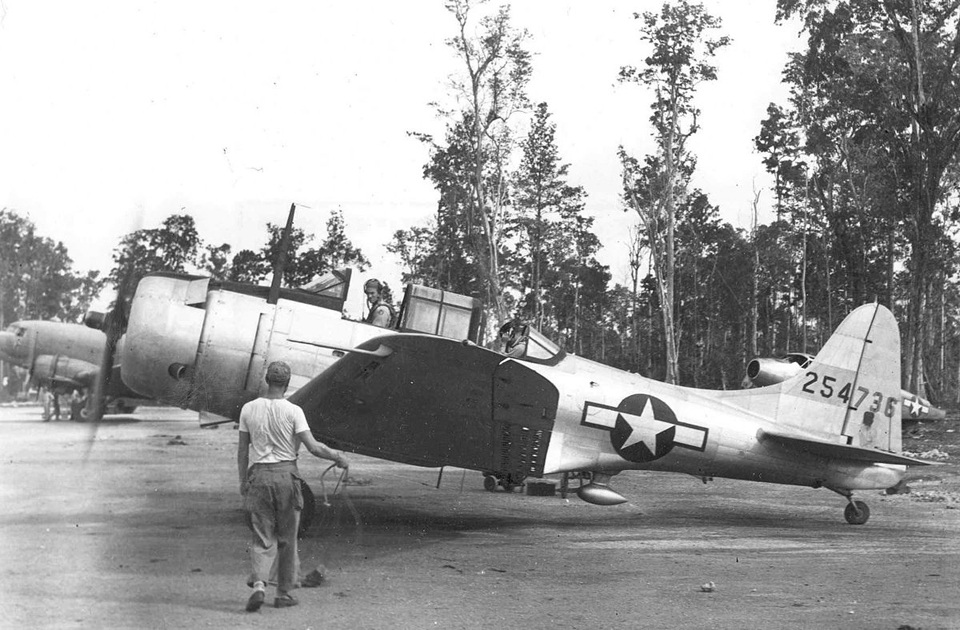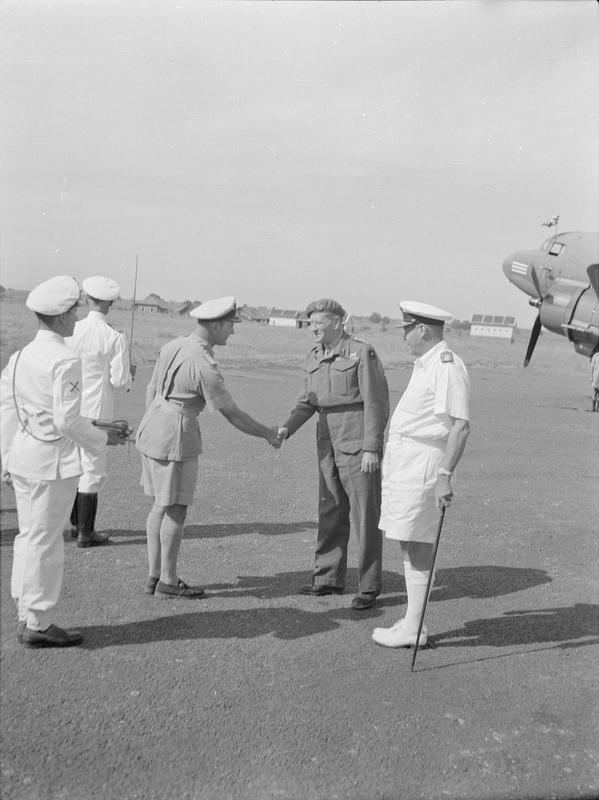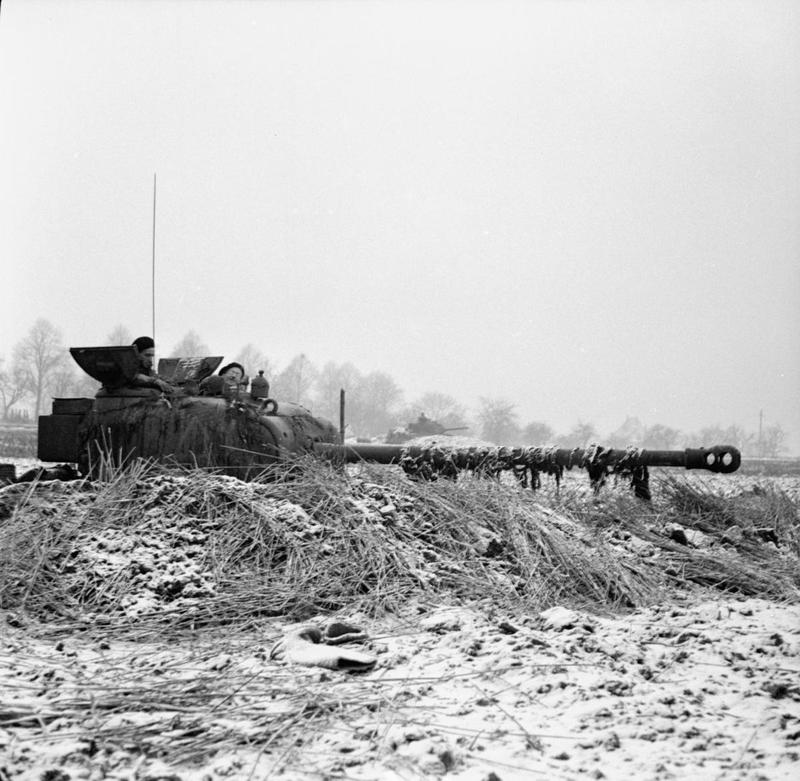Air Operations, CBI
BURMA- 71 10th Air Force P-47s and P-38s attack troops, tanks, motor vehicles, supplies, fuel dumps, and occupied villages at 7 locations and areas.
- 4 P-47s attack targets of opportunity along the Irrawaddy River.
- During the night, 4 10th Air Force B-25s harass lines of communication.
- 3 308th Heavy Bomb Group B-24s attack Fort Bayard.
- 40 14th Air Force P-40s and P-51s attack artillery positions, rail targets, warehouses, and industrial facilities between Puchi and Yoyang.
- 47 P-40s and P-51s attack troops, horses, road and rail traffic, and occupied towns at Liuchenghsien and between Hsuchang and Siaokan.
- 8 P-51s attack the airfield at Suchow.
Air Operations, East Indies
- FEAF B-24s, B-25s, and fighter-bombers attack various targets, including bivouacs, airfields, and shipyards.
- 3 42nd Medium Bomb Group B-25s crash into a mountain while operating in bad weather.
Air Operations, Europe
The Luftwaffe makes a series of heavy attacks on Allied airfields in Belgium, Holland and northern France. It is called Operation BODENPLATTE/HERMANN. They have assembled around 800 planes of all types for this effort by scraping together every available machine and pilot. Many of the pilots have had so little training that they must fly in special formations with an experienced pilot in the lead providing the navigation for the whole force. The Allies are largely taken by surprise and lose many aircraft on the ground. Among the German losses for the day are a considerable number of planes shot down by 'friendly' anti-aircraft fire. The results are disastrous for the Luftwaffe as 364 of their aircraft are downed. About 125 Allied planes are lost but operations continue from the target fields. The Allied planes can be replaced immediately, but for the Germans neither the planes nor the pilots can be.
RAF BOMBER COMMANDEvening Ops:
- 152 Lancasters and 5 Mosquitos of No. 5 Group carry out an accurate attack on the Gravenhorst section of the Mittelland Canal. Half a mile of banks are pitted with bomb craters and some parts are breached.
- There are no aircraft losses.
- 146 aircraft of No. 3 Group successfully attack the railway yards at Vohwinkel.
- 1 Lancaster is lost.
- 105 Halifaxes of No 4. Group and 18 Lancasters and 16 Mosquitos of No. 8 Group are sent to bomb a benzol plant at Dortmund, but the attack is scattered and the plant is not hit.
- There are no losses.
- 28 Mosquitos are sent to Hanau and 27 to Hannover, both on 'spoof' raids, and there are 59 Mosquito patrols and 42 RCM sorties. The No. 100 Group Mosquitos claim 6 German night fighters destroyed.
- 4 Mosquito squadrons toss 4,000-lb delayed action bombs into railway tunnels east of the Ardennes. Mosquitoes of the 'Light Night Striking Force' carry out the first of 67 raids on Berlin during the January-April time period. Only 14 planes are lost and 1,459 4,000-lb bombs are dropped on target.
GERMANY:
- Only 11 of 428 1st Air Division B-17s dispatched against an oil-industry target at Magdeburg attack the primary. 292 1st Air Division B-17s attack a marshalling yard at Kassel (secondary). 26 1st Air Division B-17s attack a marshalling yard at Gottingen. 99 1st Air Division B-17s attack numerous targets of opportunity.
- 86 2nd Air Division B-24s attack two rail bridges at Koblenz.
- 57 2nd Air Division B-24s attack a rail bridge at Irlich.
- 6 2nd Air Division B-24s attack the rail bridge at Remagen.
- 42 2nd Air Division B-24s attack several targets of opportunity.
- 54 3rd Air Division B-17s attack an oil-industry target at Dollbergen.
- 24 3rd Air Division B-17s attack an oil-industry target at Ehmen.
- 21 3rd Air Division B-17s attack several targets of opportunity.
- 8 heavy bombers and 2 of 626 VIII Fighter Command escorts are lost.
BELGIUM:
- At approximately 0930 hours, as 12 P-51s of the 352nd Fighter Group's 487th Fighter Squadron are taking off from their temporary base near Liege for an area patrol, the airfield comes under attack and the P-51s are jumped by about 50 FW-190s and Bf-109s. Within minuts, the squadron routs the attack force and accounts for 20 of the Luftwaffe fighters destroyed withoud loss to itself.
- 190 9th Air Division bombers attack lines-of-communicatin target and a German Army command post in Belgium and Germany.
ITALY:
- 12th Air Force B-25s attack bridges at three locations.
Air Operations, Marianas
A 6th Night Fighter Squadron P-61 downs a G4M 'Betty' bomber over Tinian at 0450 hours.
[Air Operations, Philippines
- 494th Heavy Bomb Group B-24s dispatched against Clark Field, Luzon are diverted to a secondary target due to bad weather.
- FEAF B-24s attack the Sasa area.
- V Bomber Command B-25s and V Fighter Command fighter-bombers attack various targets on Negros at low level.
- B-25s attack a barracks at Laoag.
- Fighter-bombers attack the Manila area and Silay on Negros.
- 49th and 475th Fighter group P-38s down a Ki-46 'Dinah' reconnaissance plane and 11 fighters over Luzon between 1050 and 1126 hours.
- During the night, an American cargo ship is struck by a bomb and beached off Mindoro.
Air Operations, Volcano Islands
- 19 VII Bomber Command B-24s attack Iwo Jima.
- During the night, 9 VII Bomber Command B-24s conduct snooper raids against Iwo Jima.
Caroline Islands
Small units from the US 81st Inf Div land on Fais Island, southeast of Ulithi, and begin a detailed reconnaissance with the objective of capturing and destroying a Japanese radio station.
[CBI
Maj-Gen George E. Stratemeyer's Eastern Air Command is flying 2,000 tons of supplies to Allied forces in Burma to sustain the offensive against the Japanese defending along the Akyab-Mandalay-Wanting line.
[Eastern Front
As a result of the defeats they have suffered, the Germans now have to hold a front against the Russians and their Allies reduced from 2,750 miles to 1,400 miles. In the far north it runs from west of Petsamo and Kirkenes, to Lake Inari. South of the Baltic the German Army Group North is faced with threat of encirclement in northern Latvia. In East Prussia Memel is also isolated, and the rest of the front more or less follows the border of the German province. The line of the Narew, the Vistula and the San marks the front in Poland, with a big Russian salient in the south in the Sandomierz area. The extreme eastern part of Slovakia is in Russian hands, while in Hungary the Red Army is fighting in Budapest and has established itself along a line that, from the Czechoslovakian frontier, runs south as far as the Magyar capital, then turns west as far as Lake Balaton and south again to the Drava, and then penetrates into Yugoslavia, where the front is more fluid; the Germans have partly evacuated the Balkans, but not completely. Such fighting as there is, however, consists of rearguard actions.
Against the Russian forces the Germans can still, at the beginning of 1945, deploy 3,100,000 men, out of a total of 5,350,000 'operational' effectives, besides the reserve, with 28,500 guns and mortars, 4,000 tanks and self-propelled guns and 1,960 combat aircraft.
Russian forces add up to 11,500,000 men, of whom 6,000,000 are combatants, with 108,000 guns and mortars, 12,900 tanks and self-propelled guns and 15,540 aircraft. Their armament has more than doubled since the beginning of 1944, whereas that of the Germans has been reduced in the same period by 26,000 guns, 1,450 tanks and self-propelled guns and 1,113 aircraft.
On New Year's Day the furious fighting in and around Budapest goes on.
SOUTHERN SECTORBitter fighting continues in Pest as the Soviets pound the 10th and 12th Hungarian Divisions. Soviet forces have finally entered the main metropolitan area of Pest after some hard fighting.
[Italy
An almost complete calm reigns over the whole front on the first day of the year, with Gen Sir Richard McCreery's 8th Army dug in on the banks of the Senio River, in the flat country of Romagna, and Lucian Truscott's 5th Army 10 miles from Bologna. The lull in the fighting is to last many weeks, allowing the units of Heinrich von Vietinghoff's Army Group C, the 10th and 14th Armies of Gens Traugott Herr and Joachim Lemelsen, to strengthen their defenses, and Gen Mark Clark, who has succeeded Harold Alexander in command of the Allied forces in Italy, to perfect his plans for the final offensive.
[Pacific
The Japanese cargo vessel Kyokko Maru (593t) is sunk by mine, laid by the British submarine Tradewind on October 30, off Mergui, Burma.
[Philippines
To deceive the Japanese about the Allied plans for the invasion of Luzon, the Americans carry out mopping-up operations in the northeast of Mindoro. After that, nuisance operations will be carried out in the southern part of Luzon.
On Leyte the US 8th Army begins mopping up, which will go on until May 8.
[Poland
The communist Lublin committee declares itself the legitimate government of Poland.
[Soviet Union, Strategy
With 11,500,000 troops under its command, the Stavka begins the new year with the resolution and resources to bring the war on the Eastern Front to an end. The 2nd Belorussian (881,000 troops) and 3rd Belorussian (708,000 troops) Front will strike into East Prussian and Pomerania to attack Army Group Center. The 1st Belorussian (1,028,000 troops) and 1st Ukrainian (1,083,000 troops) Fronts will annihilate Army Group A, advance to the Oder and Neisse Rivers and then capture Pomerania and Silesia.
[Western Front
The counter-thrust against the Germans by the III and VIII Corps of Pattons 3rd Army continues in the Ardennes; Moirey(?), Jenneville and Chenogne are recaptured by the 87th Div of the VIII Corps, while units of the III Corps succeed in containing the German salient southeast of Bastogne. In Alsace, in the southern part of the front, units of the German Army Group G under Gen Hermann Balck, about 10 divisions but understrength, launch an offensive against Gen Alexander Patch's 7th Army, 'Operation NORDWIND', which is forced to withdraw. On precise orders from Gen Eisenhower, the formations of the 6th Army Group, and the US 7th Army in particular, are to evacuate Alsace and withdraw westwards to a new front on the crest of the Vosges, on the Maginot Line, and then occupy, on their left, a line Bitche-Strasbourg, and finally by January 5, the line from Bitche to Dabo.
[Images from January 1, 1945
|
|
|
|
|
|
|
|
